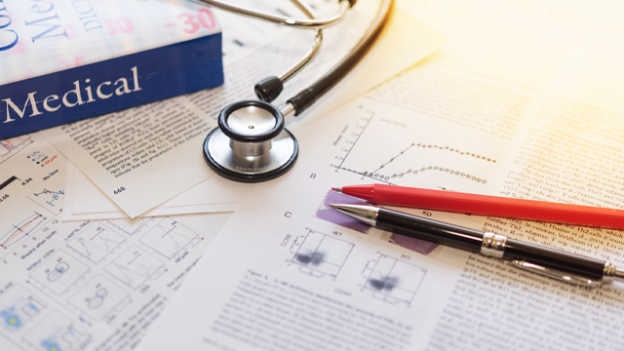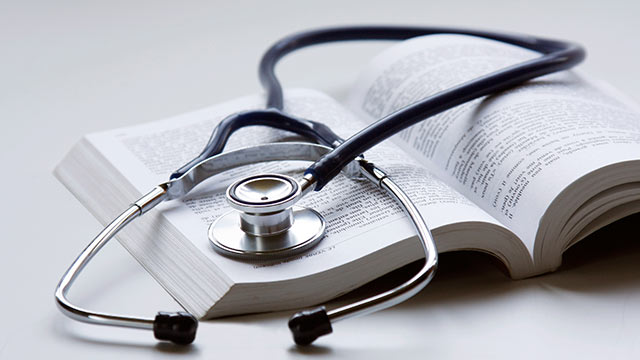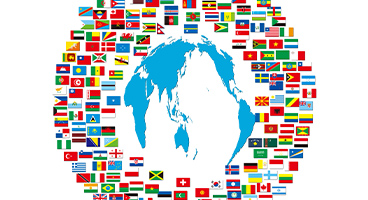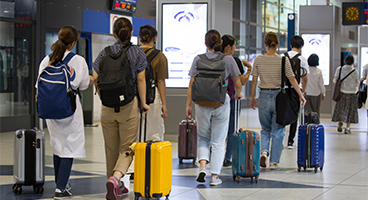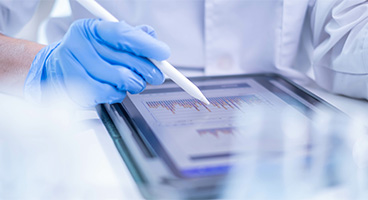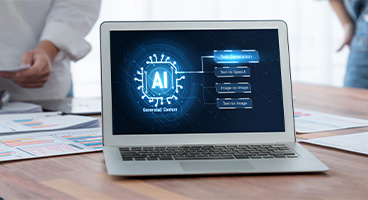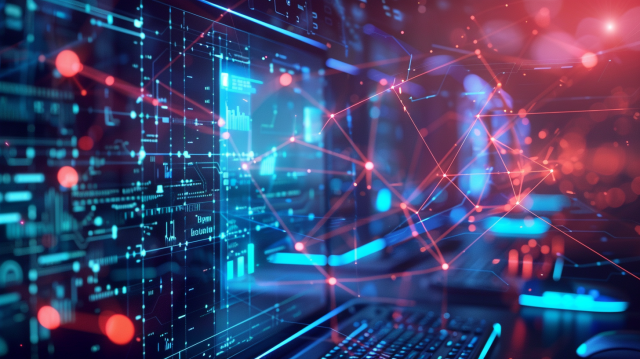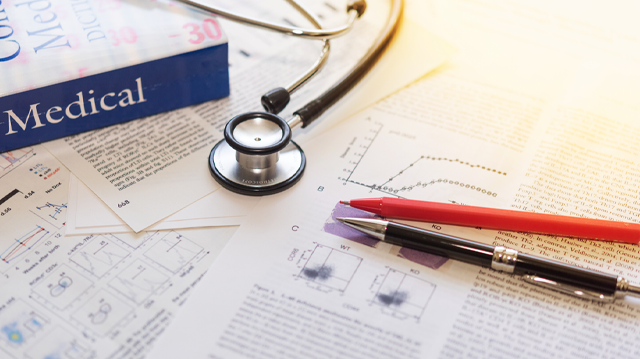
The staff at Human Science is working daily to improve the efficiency of translations using ChatGPT, and we regularly share the results on our blog. This time, we will introduce the verification results focusing on the "efficiency improvement" of "medical translation" using "prompts."
- Table of Contents
-
- 1. Verification Results of Medical Translation Conducted with ChatGPT
- 1-1. Verifying Medical Translations with ChatGPT
- 1-2. Verifying ChatGPT Prompts
- 2. How to Improve the Efficiency of Medical Translation with ChatGPT? Here are Some Attempts
- 2-1. Can unnecessary line breaks that occur within a single sentence be removed? → "Please remove unnecessary line breaks"
- 2-2. Is it possible to extract the differences between the original text and the back translation (BT) check? → "Please list the parts of 'Text 1' and 'Text 2' that are 'semantically' different."
- 2-3. Can you extract frequently used words? → "Extract the top 10 terms that appear multiple times in the following text."
- 2-4. Can the translator convert dialects and peculiar speech patterns into standard language for better understanding? → "Please convert the following text's rough speech style into clear standard language."
- 2-5. Can the search time for regular expressions be shortened? → "Please tell me the regular expression for XXXX."
- 2-6. Is it possible to generate translations without word order distortion using brackets?
- 3. Summary
- 3-1. Medical translation with ChatGPT can be efficient
- 3-2. Leave medical translation to Human Science
1. Verification results of medical translation conducted with ChatGPT so far

On the Human Science blog site, we have previously introduced the results of medical translation verification using ChatGPT in two articles.
1-1. Verify Medical Translations with ChatGPT
"ChatGPT and Medical Translation" includes,
・Inputting only the Methods of a medical paper as is and attempting to create a summary
・Attempting to translate the Introduction and Methods of the same paper as above
・Verifying whether it can be used for research during translation checks
.
Simply saying "Please create a summary" does not yield the desired results, and there are issues such as character count limitations per output for translations. However, for auxiliary tasks related to translation, such as confirming background knowledge, while checking the accuracy of information is necessary, it seems to be highly useful.
1-2. Validate ChatGPT Prompts
"ChatGPT and Medical Translation ② Is 'Prompt' Effective in Medical Translation? I Tried It" does the following:
- Using clinical trial consent and explanatory documents as subjects, it specifies translations of medical terms.
- Using conference presentation scripts as subjects, it examines subtitle translation with word count limitations.
We also discussed how, by grasping certain tips for prompt creation, it can become a highly useful tool.
If you are interested, please take a look.
2. How to Improve the Efficiency of Medical Translation with ChatGPT? Here are Some Attempts
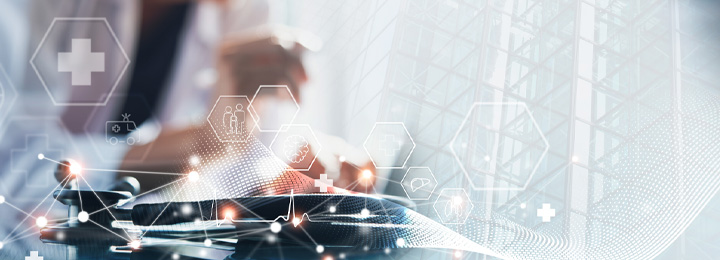
In our Medical Group, we have been validating effective prompts for utilizing ChatGPT in various peripheral tasks that arise in medical translation. Here, we will introduce some of them.
2-1. Can unnecessary line breaks that occur within a single sentence be removed? → "Please remove unnecessary line breaks"
When generating PDFs or creating SRT files (files used for subtitles), unnecessary line breaks may occur within the text. This can result in a single sentence being split into two, causing issues when using machine translation or translation support tools. However, the line breaks were successfully removed using the prompt above.
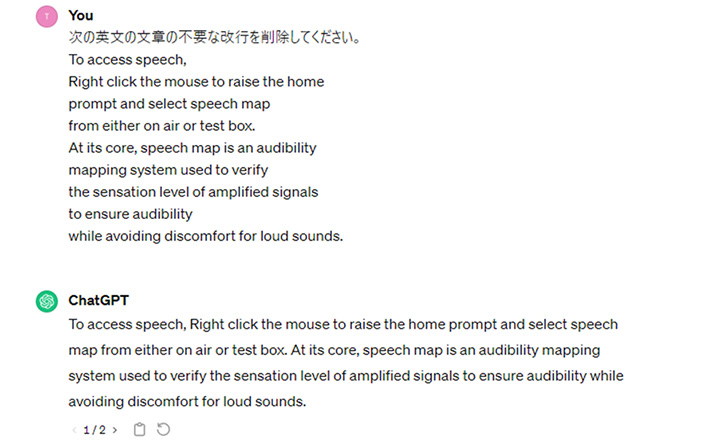
Additionally, the prompt "Please break each sentence after a period (or a comma in Japanese)" allows for line breaks after each sentence, making tasks like subtitle translation and other translation-related work easier.
While this can also be done using Word's replace function, the advantages include the ability to give simple verbal instructions, fewer operational steps, and results that are intuitively easy to understand.
2-2. Is it possible to extract the differences between the original text and the back translation (BT) check? → "Please list the semantically different parts of the following 'Text 1' and 'Text 2.'"
During the translation process, there are times when we incorporate a step called back translation. This involves creating a translation (referred to as a back translation: BT) using the translated text of the original document and comparing it with the original text to check for any mistranslations.
Since the original text and the BT text are rarely identical even if there are no mistranslations, we attempted to devise prompts to extract "semantically different parts" so that we could avoid extracting sentences that are merely expressed differently but have the same meaning, and instead focus on identifying parts where the meaning has changed due to mistranslation.
As a result, when we intentionally changed the original text "Inclusion Criteria" to the opposite meaning "Exclusion Criteria" in the BT text for verification, that specific part was clearly pointed out.
Of course, there are parts that were not pointed out by ChatGPT that still need to be checked by humans, but it seems to have a certain effectiveness as one of the checking methods.
2-3. Can you extract frequently used words? → "Extract the top 10 terms that appear multiple times in the following text."
Not limited to the medical field, having a glossary in industrial translation improves work efficiency.
If you create a bilingual list by picking out important terms from translated documents, it will be very helpful for subsequent translations.
In a report related to psychiatry, terms such as BZRA (benzodiazepine receptor agonist), abuse patients, and over-the-counter medications were picked up. Furthermore, by entering the prompt "Please tell me how many times each term appears," the frequency of the extracted terms was also shown, and there were no errors in the presented occurrence numbers.


On the other hand, since words like "2018" are chosen that are not suitable as terms, caution is necessary when actually implementing this. However, it is easy to create translations in order of frequency of appearance in the document, and depending on the ingenuity of the prompts, it seems possible to extract only important terms.
2-4. Can the translator convert dialects and peculiar speech patterns into standard language for better understanding? → "Please convert the following text's rough speech style into clear standard language."
When a native English speaker translates Japanese, the accuracy of the translation can often be affected if the speaker has a unique tone, dialect, or uses archaic language.
In a somewhat unusual case, when I tried to convert Japanese spoken in a "beranme" tone to standard Japanese, there was a tendency to condense the content, but they attempted to rewrite it into standard language. While human oversight is necessary, I got the impression that it could save time compared to starting from scratch.
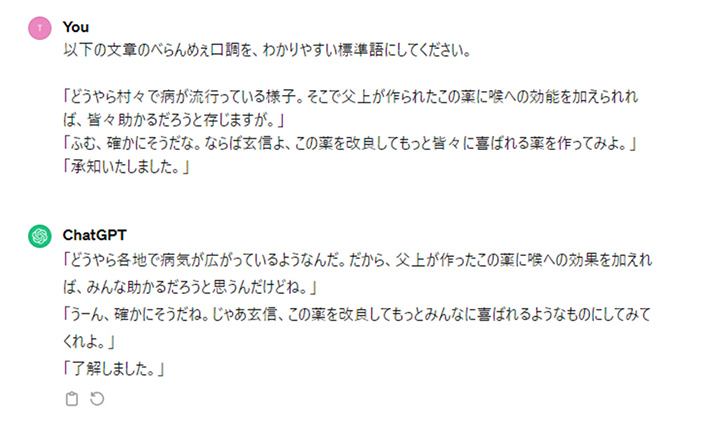
2-5. Can the search time for regular expressions be shortened? → "Please tell me the regular expression for XXXX."
Regular expressions are effective for improving translation efficiency.
In the first place, regular expressions, such as "^[a-zA-Z0-9]+$", may seem like a meaningless string of characters to those unfamiliar with programming, but by using regular expressions, you can perform complex string searches and replacements, thereby increasing the efficiency of processing various strings.
For example, in a business context, they can be used for purposes such as "extracting only the strings that appear to be phone numbers from a vast amount of text data."
In the case of Japanese-English translation, there is no need to translate parts that are already in English or alphanumeric characters in charts and graphs. If you can extract only those using regular expressions and exclude them from the translation target in advance, the more extensive the document, the greater the efficiency gain.
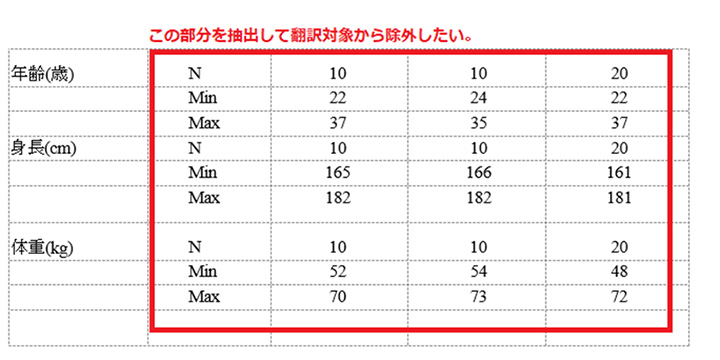
However, it can be surprisingly difficult to search the web for information on a "regular expression that extracts only half-width alphanumeric characters," and there may be a belief that one should learn about "regular expressions" from the basics. In such cases, if you instruct ChatGPT with "Please tell me the regular expression that extracts only half-width alphanumeric characters," you can get the exact regular expression you are looking for: "^[a-zA-Z0-9]+$".
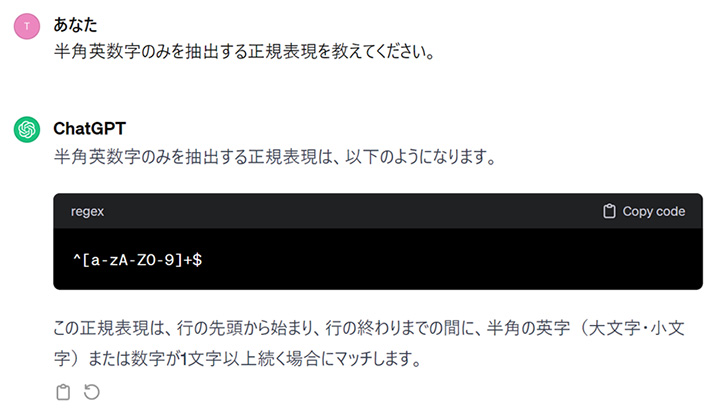
By using this regular expression, you can search and extract in translation support tools such as Word and Trados, and exclude non-translatable half-width alphanumeric characters from the translation target.
2-6. Is it possible to generate translations without word order disruption using brackets?
While strict post-editing by humans is essential, current translations cannot be considered without machine translation.
However, if the original text is lengthy, it is prone to errors in dependency, and an unexpected blind spot occurs when there are many instances of "" or () (in English, " " or [ ]). In the worst case, the translated text may collapse as a coherent sentence.
Moreover, lengthy texts with abundant parentheses frequently appear in clinical trial-related documents and medical papers.
It is possible to instruct ChatGPT to remove "" or (), " " or [ ], but that can also be done with Word's replace function.
Therefore, when translating lengthy clinical trial-related documents with abundant parentheses directly with ChatGPT, it was found that ChatGPT was less affected by the negative impacts of long sentences and parentheses.
We would like to continue verifying reproducibility and other aspects regarding this.
In addition to the above, we are currently verifying whether it is possible to display official translations only for parts corresponding to UI elements such as Windows that occasionally appear in instruction manuals for medical devices, and whether it is possible to extract only specific languages from multiple languages, among other things.
3. Summary
3-1. Medical translation with ChatGPT can be efficient
In conclusion, we have introduced various translation-related tasks that can be made easier depending on the ingenuity of the prompts, such as extracting frequently used terms, searching with regular expressions, rewriting into a more translatable style, and removing forced line breaks.
There are concerns about AI potentially taking away human jobs, but as someone currently in the translation industry, I have gained a new impression that it may be better to actively and skillfully navigate AI and adopt a stance of using what can be used.
3-2. Leave medical translation to Human Science
Human Science is well-known for its efficiency in translation work using machine translation and translation support tools. Additionally, we are constantly exploring the efficiency of translation and related tasks utilizing AI such as ChatGPT, and we share our findings with everyone on our blog.
We also offer human translation services and post-editing services. By utilizing translation assistance (CAT) tools such as Trados and Phrase TMS (formerly Memsource), as well as machine translation tools, we are committed to improving translation efficiency and quality, contributing to our clients' further development.
Please try our medical translation services in human sciences, equipped with high expertise in both document technology and medical science.
If you have any concerns or interests, please feel free to contact us.
Medical Translation Services
Post-Editing Services
In addition, we provide information related to medical/healthcare translation, such as the following. We hope you find it useful.
Related Blog Posts
What is Medical and Pharmaceutical Translation? Reasons for Difficulty and Points for Selecting a Service Provider
What is the Translation Accuracy of DeepL in Medical Translation? Comparison Results with Google/Microsoft/Amazon
Has the Accuracy of Medical Translation Improved? A Comparison of DeepL and Google Translate from 2020 to 2023
Introducing Books that Helped Professionals in Medical Translation Improve Quality!
What is Life Sciences? An Explanation of the Importance of Life Sciences Research and How to Obtain High-Quality Translations!

